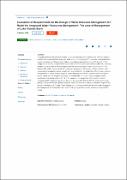Evaluation of requirements for the design of water resource management ICT model for integrated water resources management: the case of management of lake Victoria basin

View/
Date
2020-05-18Author
Odongtoo, Godfrey
Lating, Peter O.
Ssebugwawo, Denis
Metadata
Show full item recordAbstract
The paper addresses the use of partial least square-structural equation modelling (PLS- SEM) technique to evaluate the requirements for a design of a water resource management (ICT) model for an integrated water resource management. Researchers employed a quantitative approach using smart-PLS version 3. The sample size of 152 was computed from a population size of 245 across some districts within LVB. This study revealed the perceptions of different experts based on their experiences in water resource sectors. The findings of the study discovered that distribution and management, efficient use, pollution reduction, water conservation & storage factors had a significantly positive effect on the design of an effective water resource management ICT model. Pollution reduction had the highest path coefficient (beta=0.536) thus having the highest influence on the design of water resource management ICT model. The four exogenous latent constructs wholesomely explained 65.2% of the variance in the design of an effective water resource management ICT model that was also confirmed by the value of R 2 being 0.652. The study recommends putting a special attention on a pollution reduction related requirement to achieve an effective design of water resource management ICT model. These findings can support practitioners and decision makers engaged in the management of LVB and other water bodies in designing an effective water resource management ICT model.
